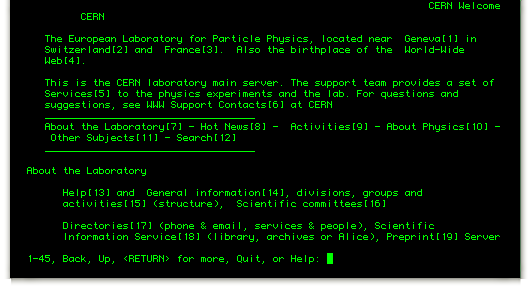 When Tim Berners-Lee first invented the Web back in 1989, he was more concerned about hyperlinks than hypermedia. Those of us old-timers remember that for those early years, the Web was 100% text, with the most exciting thing on the page being those underlined links in blue. It wasn’t until several years later that the first graphics were introduced, and since then we have continued to demand more from our websites, with audio and video content and real-time interactions now more the norm than the exception.
When Tim Berners-Lee first invented the Web back in 1989, he was more concerned about hyperlinks than hypermedia. Those of us old-timers remember that for those early years, the Web was 100% text, with the most exciting thing on the page being those underlined links in blue. It wasn’t until several years later that the first graphics were introduced, and since then we have continued to demand more from our websites, with audio and video content and real-time interactions now more the norm than the exception.

Experience the Future of the Web…2WAYS
June 13-14, Columbia University, NYC
Tickes from $495 – Sign up Now
Day 1 Schedule
- When Disruptions Collide: Political Uprisings and Social Media
- Fred Wilson Keynote
- Teen Sexting and its Impact on Tech Companies
- Q&A With Jason Calacanis
- Creative Exploitation of Social Media from The Swine Flu to The Onion
- Chris Dixon and His Extraordinary Machines
- Flipboard & The Future of Media Consumption
- Life is a Game: Foursquare and the Future of Location
- How W3C’s Open Web Platform is Transforming Industries
Don’t miss more sessions and speed geeking on Day 2!
(That is what the Web looked like back in 1992: all text, all the time.)
But today’s Web isn’t about just posting all kinds of content, but being able to interact with it in real time: to buy stuff, to seek out specific answers to our questions, to share with what our peers are working on, to be fully engaged with all of our senses. That is a lot more than just requesting a page of text from a Web server.
Next week, at our 2WAY Summit in New York City, I will be moderating a panel to address these and other issues surrounding real-time communications. To help illustrate where we have come and where we need to go, I have assembled for my panel four representatives of companies that are pushing the envelope. The companies include:
- Tokbox Inc., which enables group video chat apps on a website,
- Radish Systems, which sells ChoiceView, an iPhone/iPad app that enables real-time interactions and data transfer with call center agents,
- Twilio Inc., sells its Cloud Communicator which enables voice and texting interaction with a website using a variety of programming languages and tools,
- 5 Min Media, is a leading how-to video repository and syndicator that is now part of AOL.
All of these vendors have various programming interfaces, widgets and tools to make it easier to share audio and video content on a website: the goal is to make your site more engaging and keep a visitor browsing and have a site stand out from others that are more static.
The bad news is that we are still in the early days of how a particular browser supports this content: if we are going to post something in Flash, for example, that cuts out all the iPad users out there. If we embed a video player, that means we tie ourselves closer to the source site that serves up that content. If we make use of a widget that works on our current Web server, it might fail when we upgrade to a newer version.
Come join me and my panel next Tuesday as we’ll talk about these issues and see some really innovative sites built using these tools.

0 Responses
Stay in touch with the conversation, subscribe to the RSS feed for comments on this post.